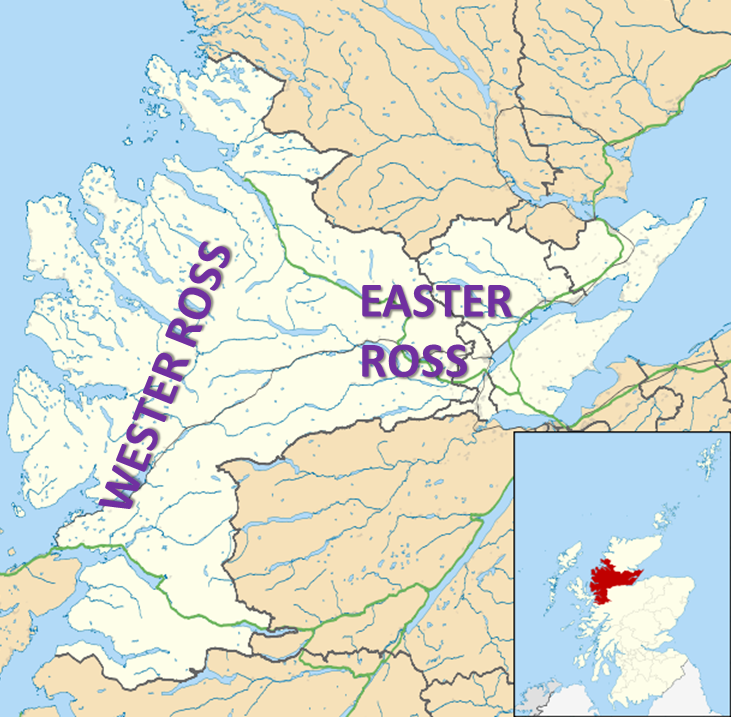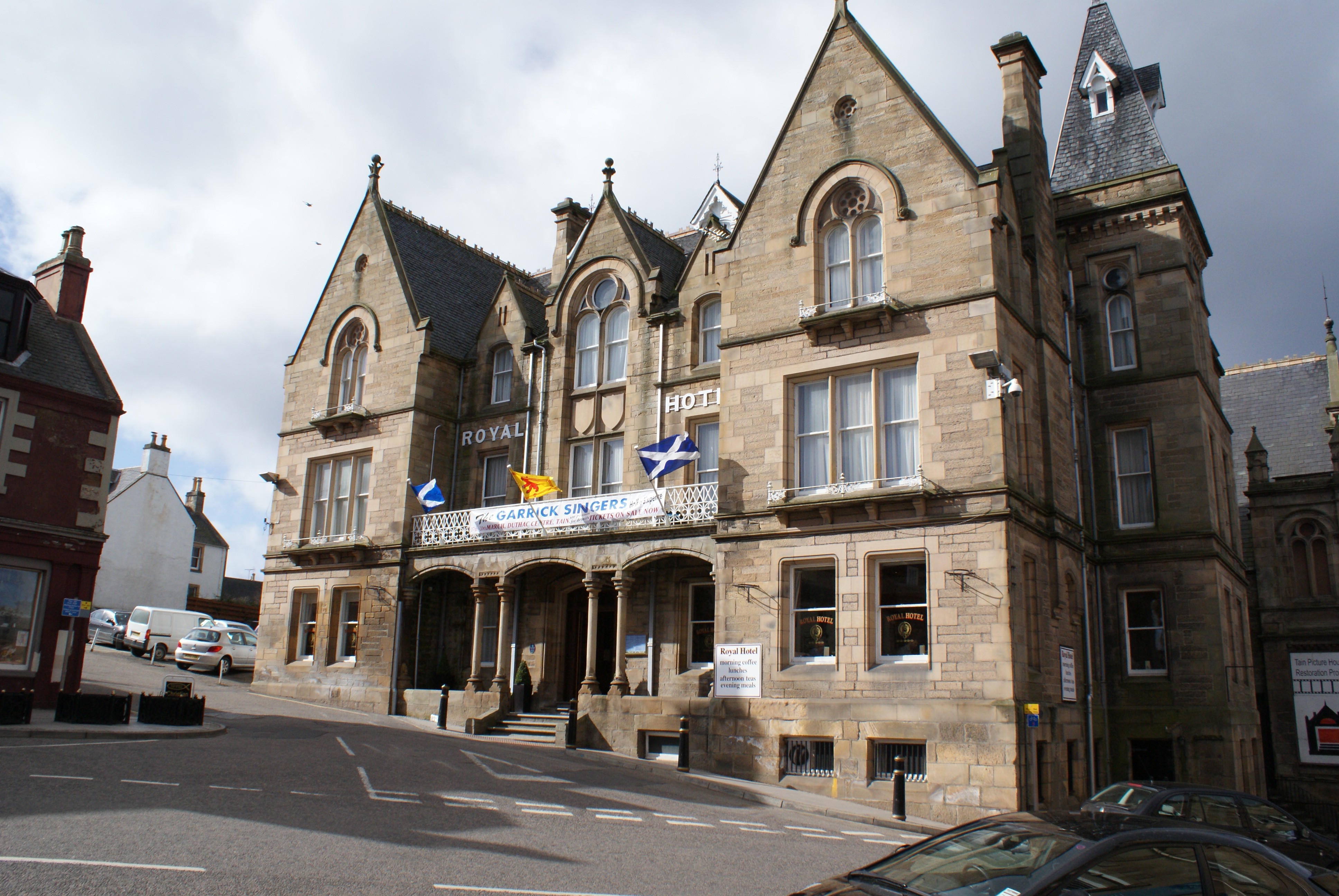|
Edderton Cross Slab
Edderton Cross Slab is a Class III Pictish stone standing in the old graveyard of the village of Edderton, Easter Ross. The stone is of red sandstone. On the western side there is an undecorated but elegant celtic cross, the circles within its rings emphasised by being left in relief. On the eastern side there is another cross on the upper half, standing on a semi-circular base or arch, within which is a horseman in relief, with two further riders incised below. The slab was formerly sunk considerably deeper in the earth, concealing the lower two horsemen, but has recently been raised to its presumed original height (notice the lack of lichen on the lower half in the accompanying photograph). This monument should not be confused with the Edderton Symbol Stone, or Clach Biorach ("Pointed Stone"), a red sandstone pillar of Bronze Age origin with Pictish symbols incised on it, which stands in a field near the village of Edderton a little to the west. Further fragments of early m ... [...More Info...] [...Related Items...] OR: [Wikipedia] [Google] [Baidu] |
Pictish Stone
A Pictish stone is a type of monumental stele, generally carved or incised with symbols or designs. A few have ogham inscriptions. Located in Scotland, mostly north of the Clyde-Forth line and on the Eastern side of the country, these stones are the most visible remaining evidence of the Picts and are thought to date from the 6th to 9th century, a period during which the Picts became Christianized. The earlier stones have no parallels from the rest of the British Isles, but the later forms are variations within a wider Insular tradition of monumental stones such as high crosses. About 350 objects classified as Pictish stones have survived, the earlier examples of which holding by far the greatest number of surviving examples of the mysterious symbols, which have long intrigued scholars. [...More Info...] [...Related Items...] OR: [Wikipedia] [Google] [Baidu] |
Graveyard
A cemetery, burial ground, gravesite or graveyard is a place where the remains of dead people are buried or otherwise interred. The word ''cemetery'' (from Greek , "sleeping place") implies that the land is specifically designated as a burial ground and originally applied to the Roman catacombs. The term ''graveyard'' is often used interchangeably with cemetery, but a graveyard primarily refers to a burial ground within a churchyard. The intact or cremated remains of people may be interred in a grave, commonly referred to as burial, or in a tomb, an "above-ground grave" (resembling a sarcophagus), a mausoleum, columbarium, niche, or other edifice. In Western cultures, funeral ceremonies are often observed in cemeteries. These ceremonies or rites of passage differ according to cultural practices and religious beliefs. Modern cemeteries often include crematoria, and some grounds previously used for both, continue as crematoria as a principal use long after the interment a ... [...More Info...] [...Related Items...] OR: [Wikipedia] [Google] [Baidu] |
Edderton
Edderton ( gd, Eadardan) is a village near Tain, lying on the shores of the Dornoch Firth, Easter Ross and is in the Highland council area of Scotland. It has approximately 388 inhabitants. It is the location of the Balblair Distillery, and of the Edderton Cross Slab, a Class III Pictish stone, which lies in the old churchyard of the village. A quarter of a mile outside the town lies another stone, the ''Clach Biorach'', a Class I Pictish stone. The former Ardmore House was a home of the chiefs of clan Ross. Balblair distillery off Station Road, Edderton, dates back to about 1800: in 1846, it was recorded that it consumed 120 bushels of malt weekly, producing 240 gallons of whisky, of very high repute. The distillery and village were served by the Inverness and Aberdeen Junction Railway from 1864 until Edderton railway station Edderton railway station served the village of Edderton, Highland (council area), Highland, Scotland from 1864 to 1960 on the Inverness and Ross-sh ... [...More Info...] [...Related Items...] OR: [Wikipedia] [Google] [Baidu] |
Easter Ross
Easter Ross ( gd, Ros an Ear) is a loosely defined area in the east of Ross, Highland, Scotland. The name is used in the constituency name Caithness, Sutherland and Easter Ross, which is the name of both a British House of Commons constituency and a Scottish Parliament constituency. The two constituencies have however different boundaries. Settlements Places in Easter Ross include: * Alness * Dingwall (included in some contexts in the term ''Easter Ross'', though in some contexts it refers to the area to the north-east of Dingwall) * Evanton * Invergordon * Kildary * Milntown of Tarbat (Milton) * Portmahomack * The Seaboard villages: ** Balintore ** Hilton of Cadboll ** Shandwick * Tain Tain ( Gaelic: ''Baile Dhubhthaich'') is a royal burgh and parish in the County of Ross, in the Highlands of Scotland. Etymology The name derives from the nearby River Tain, the name of which comes from an Indo-European root meaning 'flow'. The ... Easter Ross is well known ... [...More Info...] [...Related Items...] OR: [Wikipedia] [Google] [Baidu] |
Sandstone
Sandstone is a clastic sedimentary rock composed mainly of sand-sized (0.0625 to 2 mm) silicate grains. Sandstones comprise about 20–25% of all sedimentary rocks. Most sandstone is composed of quartz or feldspar (both silicates) because they are the most resistant minerals to weathering processes at the Earth's surface. Like uncemented sand, sandstone may be any color due to impurities within the minerals, but the most common colors are tan, brown, yellow, red, grey, pink, white, and black. Since sandstone beds often form highly visible cliffs and other topographic features, certain colors of sandstone have been strongly identified with certain regions. Rock formations that are primarily composed of sandstone usually allow the percolation of water and other fluids and are porous enough to store large quantities, making them valuable aquifers and petroleum reservoirs. Quartz-bearing sandstone can be changed into quartzite through metamorphism, usually r ... [...More Info...] [...Related Items...] OR: [Wikipedia] [Google] [Baidu] |
Celtic Cross
The Celtic cross is a form of Christian cross featuring a nimbus or ring that emerged in Ireland, France and Great Britain in the Early Middle Ages. A type of ringed cross, it became widespread through its use in the stone high crosses erected across the islands, especially in regions evangelized by Irish missionaries, from the ninth through the 12th centuries. A staple of Insular art, the Celtic cross is essentially a Latin cross with a nimbus surrounding the intersection of the arms and stem. Scholars have debated its exact origins, but it is related to earlier crosses featuring rings. The form gained new popularity during the Celtic Revival of the 19th century; the name "Celtic cross" is a convention dating from that time. The shape, usually decorated with interlace and other motifs from Insular art, became popular for funerary monuments and other uses, and has remained so, spreading well beyond Ireland. Early history Ringed crosses similar to older Continenta ... [...More Info...] [...Related Items...] OR: [Wikipedia] [Google] [Baidu] |
Clach Biorach
Clach Chairidh, alternatively named Clach Biorach (from Scots Gaelic, meaning 'the Pointed Stone'), is a Class I Pictish stone located in a field near the village of Edderton in Easter Ross. The standing stone was probably erected at some time in the Neolithic to Middle Bronze Age (4000 BC to 1500 BC), and Pictish symbols were later engraved at some time in the Late Iron Age to Early Medieval period (500 AD to 700 AD) on its north face. The symbols are a salmon above a double-disc with a Z-rod. When first recorded in 1780, a circle which is no longer visible was shown below on the left, which could have been part of a mirror. It is sandstone, 3.13m high, and at the base it has a width of 1.07m and depth of 0.46m. Gallery File:Clach Biorach.JPG, A distance photograph of ''Clach Biorach'' taken in July 2006. File:Clach Biorach (detail) - geograph.org.uk - 915411.jpg, The Pictish engravings in detail. See also *Celtic art Celtic art is associated with the peoples known as Ce ... [...More Info...] [...Related Items...] OR: [Wikipedia] [Google] [Baidu] |
Bronze Age
The Bronze Age is a historic period, lasting approximately from 3300 BC to 1200 BC, characterized by the use of bronze, the presence of writing in some areas, and other early features of urban civilization. The Bronze Age is the second principal period of the three-age system proposed in 1836 by Christian Jürgensen Thomsen for classifying and studying ancient societies and history. An ancient civilization is deemed to be part of the Bronze Age because it either produced bronze by smelting its own copper and alloying it with tin, arsenic, or other metals, or traded other items for bronze from production areas elsewhere. Bronze is harder and more durable than the other metals available at the time, allowing Bronze Age civilizations to gain a technological advantage. While terrestrial iron is naturally abundant, the higher temperature required for smelting, , in addition to the greater difficulty of working with the metal, placed it out of reach of common use until th ... [...More Info...] [...Related Items...] OR: [Wikipedia] [Google] [Baidu] |
Tain
Tain ( Gaelic: ''Baile Dhubhthaich'') is a royal burgh and parish in the County of Ross, in the Highlands of Scotland. Etymology The name derives from the nearby River Tain, the name of which comes from an Indo-European root meaning 'flow'. The Gaelic name, ''Baile Dubhthaich'', means 'Duthac's town', after a local saint also known as Duthus. History Tain was granted its first royal charter in 1066, making it Scotland's oldest royal burgh, commemorated in 1966 with the opening of the Rose Garden by Queen Elizabeth, the Queen Mother. The 1066 charter, granted by King Malcolm III, confirmed Tain as a sanctuary, where people could claim the protection of the church, and an immunity, in which resident merchants and traders were exempt from certain taxes. Little is known of earlier history although the town owed much of its importance to Duthac. He was an early Christian figure, perhaps 8th or 9th century, whose shrine had become so important by 1066 that it resulted in the royal ... [...More Info...] [...Related Items...] OR: [Wikipedia] [Google] [Baidu] |
Celtic Art
Celtic art is associated with the peoples known as Celts; those who spoke the Celtic languages in Europe from pre-history through to the modern period, as well as the art of ancient peoples whose language is uncertain, but have cultural and stylistic similarities with speakers of Celtic languages. Celtic art is a difficult term to define, covering a huge expanse of time, geography and cultures. A case has been made for artistic continuity in Europe from the Bronze Age, and indeed the preceding Neolithic age; however archaeologists generally use "Celtic" to refer to the culture of the European Iron Age from around 1000 BC onwards, until the conquest by the Roman Empire of most of the territory concerned, and art historians typically begin to talk about "Celtic art" only from the La Tène period (broadly 5th to 1st centuries BC) onwards. Early Celtic art is another term used for this period, stretching in Britain to about 150 AD. The Early Medieval art of Britain and Ireland, w ... [...More Info...] [...Related Items...] OR: [Wikipedia] [Google] [Baidu] |



Saunders_Quarry-1.jpg)


.jpg)